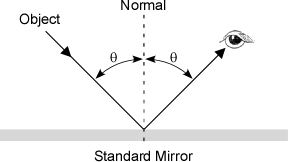1.3.1 Reflection
Mirrors are used to direct the beam of electromagnetic radiation in specific directions. Curved mirrors can be used to ensure that the beam is focused on the components of the instruments such as monochromator slits and the detector. In addition to mirror reflections, reflection also occurs any time electromagnetic radiation passes from a medium with one index of refraction into a medium with a different index of refraction. The amount of reflection tends to increase as the difference in refractive indexes between two adjacent media increases. The refractive index is defined as
![]()
where c is the speed of light in a vacuum and ci is the speed of light in a specific medium; thus, refractive index values in normal materials are always greater than or equal to 1.00. The refractive index will be important in the following sections on reflection and dispersion.
For dielectric (non-conducting) materials, as the difference in refractive indexes between two media increases, more reflection occurs. For a beam of light entering an interface at a right angle, the fraction of radiation reflected is calculated by
![]()
where Ir is the reflected intensity, Io is the intensity of the incoming beam, and η1 and η2 are the refractive indexes of the two media. The mathematical formula for metal surfaces is more complicated but the basic principle of reflection is the same.
Reflective surfaces are also present in grating systems. Common mirrors create a phenomenon that is referred to as “ordinary reflection” where an object is seen as it reflects off a mirror (Figure 1-6). Grating systems utilize higher-order diffraction arising from wave interference that will be discussed in more detail in (Section 1.3.2). Ordinary reflection can be thought of effectively as zero-order diffraction.

Figure 1-6 Ordinary Reflection (zero-order diffraction).
Reflection can also be a detriment to optimal instrumental function at the surfaces of sample containers and lenses. As the radiant light passes through the glass, the difference in refractive index of glass and air can cause reflection, which subsequently lowers the amount of incident radiation reaching the sample. Changes in the refractive indexes between these media can be overcome with the use of sample blanks and dual beam instruments (a reference light beam and a sample beam). The problem is more serious with reflective surfaces in the instrument. The composition of reflective surfaces and coatings are selected to minimize reflective losses. Reflection can decrease the source intensity since some of the light is lost. In these cases, reflection decreases sensitivity and detection limits, due to a loss of radiant intensity of the wavelength of interest.
| Frank's Homepage |
©Dunnivant & Ginsbach, 2008